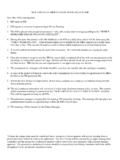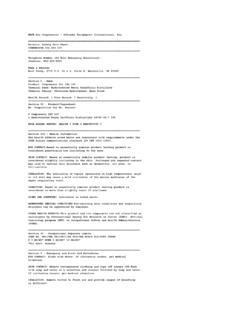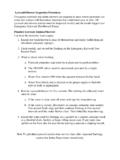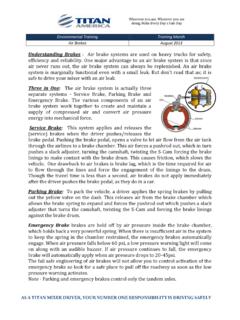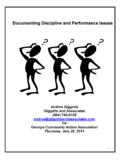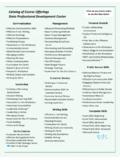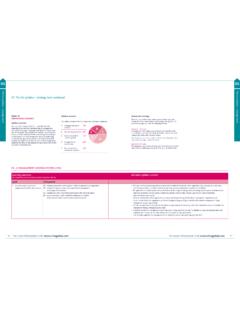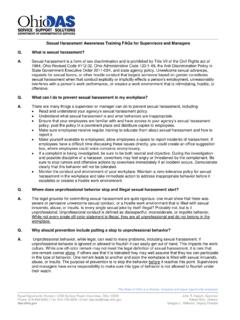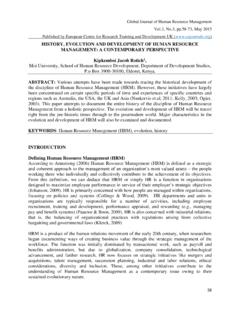Transcription of SUPERVISOR'S CHECKLIST FOR MAKING REASONABLE …
1 SUPERVISOR'S CHECKLIST FOR MAKING REASONABLE SUSPICION DETERMINATION Employee's name_____ Department_____ Date(s)_____ KNOWING THE SIGNS The indicators listed below are "warning signs" of drug and/or alcohol abuse and may be observed by supervisors: Moods: Depressed Anxious Irritable Suspicious Complains about others Emotional unsteadiness ( , outbursts of crying) Mood changes after lunch or break Actions: Withdrawn or improperly talkative Spends excessive amount of time on the telephone Argumentative Has exaggerated sense of self-importance Displays violent behavior Avoids talking with supervisor regarding work issues Absenteeism: Acceleration of absenteeism and tardiness, especially Mondays, Friday, before and after holidays Frequent unreported absences, later explained as "emergencies" Unusually high incidence of colds, flus, upset stomach, headaches Frequent use of unscheduled vacation time Leaving work area more than necessary ( , frequent trips to water fountain and bathroom) Unexplained disappearances from the job with difficulty in locating employee Requesting to leave work early for various reasons Accidents: Taking of needless risks Disregard for safety of others Higher than average accident rate on and off the job Work Patterns: 1.
2 Inconsistency in quality of work 2. High and low periods of productivity 3. Poor judgment/more mistakes than usual and general carelessness 4. Lapses in concentration 5. Difficulty in recalling instructions 6. Difficulty in remembering own mistakes 7. Using more time to complete work/missing deadlines 8. Increased difficulty in handling complex situations Relationship to Others on the Job: Overreaction to real or imagined criticism (paranoid) Avoiding and withdrawing from peers Complaints from co-workers Borrowing money from fellow employees Persistent job transfer requests Complaints of problems at home such as separation, divorce and child discipline problems OBSERVING AND documenting CURRENT INDICATORS Patterns of any of the above conduct or combinations of conduct may occur but must be accompanied by indicators of impairment in order to establish " REASONABLE cause.
3 " Please check all indicators listed below that are currently present: ____ Constricted pupils ____ Dilated pupils ____ Scratching ____ Red or watering eyes ____ Involuntary eye movements ____ Drowsiness ____ Odor of alcohol ____ Nasal secretion ____ Dizziness ____ Muscular incoordination ____ Unconsciousness ____ Inability to verbalize ____ Irritable ____ Argumentative ____ Difficulty concentrating ____ Slurred speech ____ Bizarre behavior ____ Needle marks ____ Sniffles ____ Excessively active ____ Nausea or vomiting ____ Flushed skin ____ Sweating ____ Yawning ____ Twitching ____ Violent behavior ____ Possession of paraphernalia (such as syringe, bent spoon, metal bottle cap, medicine dropper, glassine bag, paint can, glue tube, nitrite bulb, or aerosol can) ____ Possession of substance that appears to possibly be a drug or alcohol ____ Other _____ _____ _____ DETERMINING REASONABLE CAUSE If you are able to document one or more of the indicators above, ask yourself these questions to establish REASONABLE cause: Y N 1.
4 [ ] [ ] Has some form of impairment been shown in the employee's appearance, actions or work performance? 2. [ ] [ ] Does the impairment result from the possible use of drugs or alcohol? 3. [ ] [ ] Are the facts reliable? Did you witness the situation personally, or are you sure that the witness(es) are reliable and have provided firsthand information? 4. [ ] [ ] Are the facts capable of explanation? 5. [ ] [ ] Are the facts capable of documentation? 6. [ ] [ ] Is the impairment current, today, now? Do NOT proceed with REASONABLE cause testing unless all of the above questions are answered with a YES. TAKING ACTION ____ REASONABLE cause established ____ REASONABLE cause NOT established Prepared by: SUPERVISOR'S /Manager's Signature:_____
